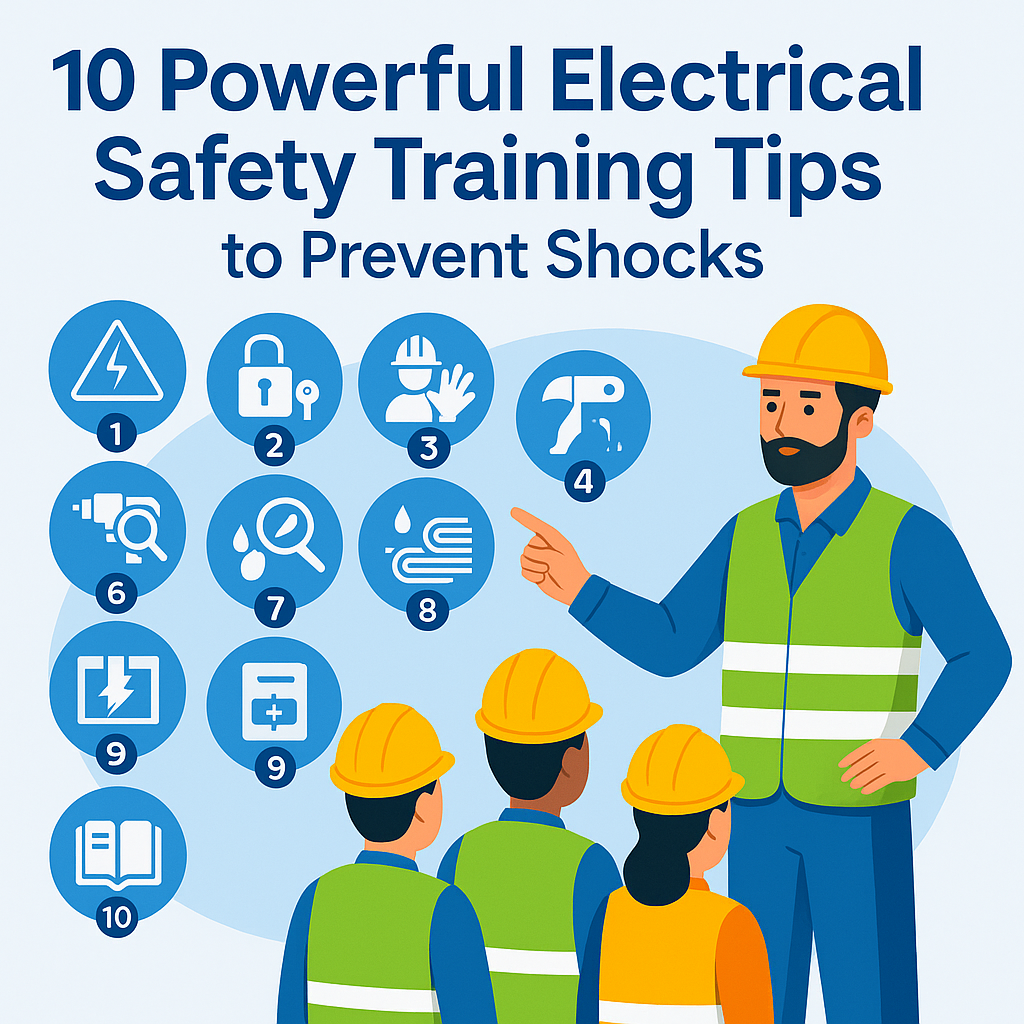
10 Powerful Electrical Safety Training Tips to Prevent Shocks
Electricity powers nearly every workplace, but it also poses serious risks when mishandled. Electrical shocks, burns, fires, and even fatalities can result from unsafe practices. Comprehensive electrical safety training helps employees understand hazards, follow safe procedures, and protect themselves.
This article outlines 10 Powerful Electrical Safety Training Tips you can teach your workforce to minimize risks and prevent electrical shocks.
1. Identify Electrical Hazards in Your Workplace
The first step in prevention is awareness. Employees should learn to:
- Recognize exposed wiring, overloaded circuits, and damaged cords.
- Identify wet areas near electrical installations.
- Understand the difference between low- and high-voltage hazards.
Example: A warehouse worker reports frayed insulation on a power cord before it causes injury.
2. Understand Lockout/Tagout (LOTO) Procedures
Energy isolation is critical when servicing equipment. Training should cover:
- How to de-energize and lockout circuits.
- Proper use of lockout devices and tags.
- Verification that equipment is completely de-energized before work.
Tip: Conduct hands-on LOTO simulations to reinforce learning.
3. Use Personal Protective Equipment (PPE) Correctly
PPE is a last line of defense but essential. Workers should know:
- Types of electrical PPE: insulated gloves, arc-flash suits, face shields, dielectric boots.
- Proper inspection and storage of PPE.
- Limitations of PPE — it does not replace safe work practices.
Example: Maintenance staff inspect their insulated gloves for pinholes before every shift.
4. Maintain Safe Work Distances
Working too close to live parts increases shock risk. Training should emphasize:
- Minimum approach distances for different voltages.
- Using insulating barriers or covers.
- Never bypassing guards or barriers.
Tip: Mark safe zones around high-voltage equipment with clear floor tape.
5. Inspect Tools and Equipment Regularly
Damaged tools can conduct electricity. Employees should:
- Check power tools for cracked casings, damaged cords, or missing ground pins.
- Use only double-insulated or properly grounded equipment.
- Remove defective tools from service immediately.
Example: An electrician tags a faulty drill and sends it for repair before anyone uses it.
6. Avoid Wet Conditions Around Electricity
Water and electricity don’t mix. Training should cover:
- Keeping cords, plugs, and outlets dry.
- Using Ground-Fault Circuit Interrupters (GFCIs) in damp locations.
- Wearing dry gloves and boots when working outdoors.
Tip: Place caution signs near wet areas with electrical equipment.
7. Follow Proper Extension Cord Practices
Improper extension cord use is a common hazard:
- Don’t daisy-chain multiple cords.
- Use cords rated for the job and environment.
- Unplug cords by the plug, not the cord itself.
- Store cords neatly to prevent damage.
Example: Office staff replace a home-use cord with a heavy-duty rated cord for a power tool.
8. Understand Circuit Protection Devices
Workers should know how fuses, breakers, and GFCIs protect them:
- Never bypass or override protective devices.
- Report frequent tripping as a warning sign.
- Reset breakers only after identifying and correcting the fault.
Tip: Show employees a panel and explain each device’s purpose.
9. Respond Properly to Electrical Emergencies
Training isn’t complete without emergency response:
- Do not touch a victim still in contact with electricity.
- Shut off power before giving aid.
- Call emergency services immediately.
- Provide CPR if trained and once it’s safe.
Example: A team practices using an emergency shutoff switch before approaching an injured coworker.
10. Refresh Training and Stay Updated
Electrical standards evolve. Workers should:
- Attend refresher courses annually or when equipment changes.
- Review new hazards and procedures regularly.
- Share lessons learned from incidents or near-misses.
Tip: Post updates on bulletin boards or company intranet.
Putting It All Together
These 10 Powerful Electrical Safety Training Tips teach employees to:
- Recognize Hazards: Spot potential electrical dangers early.
- Use Safe Practices: Follow lockout/tagout, PPE, and proper distances.
- React Effectively: Know how to respond if something goes wrong.
When every worker understands and applies these tips, you create a safer, more compliant workplace.
Additional Tips for Effective Electrical Safety Training
- Mix Methods: Combine classroom instruction with field demonstrations.
- Assess Competency: Quizzes, observations, and practical drills confirm learning.
- Track Progress: Maintain training records for audits.
- Involve Supervisors: Leadership reinforces the importance of training.
Benefits of Electrical Safety Training
- Reduced Accidents: Fewer shocks, burns, and fires.
- Lower Costs: Less downtime and fewer compensation claims.
- Improved Morale: Workers feel confident and valued.
- Regulatory Compliance: Meets OSHA/NEBOSH/ISO electrical safety requirements.
Key Takeaways
Electricity is essential but unforgiving. By teaching and reinforcing these 10 Powerful Electrical Safety Training Tips, you can significantly reduce the risk of shocks, injuries, and fatalities at work.
Suggested Internal & External Links
- External: OSHA Electrical Safety
- Internal: 12 Ultimate Fire Prevention Training Tips for Workers
- 6 Proven Emergency Preparedness Training Drills for Any Industry
- 8 Critical Fire Safety Training Lessons to Save Lives
- 10 Must-Know Workplace Safety Training Topics for Every Employee
- 5-Step Proven Safety Training Plan to Reduce Workplace Accidents
Frequently Asked Questions
1. Why is electrical safety training important?
It teaches employees how to identify hazards, use protective measures, and respond to emergencies, preventing shocks and injuries.
2. How often should electrical safety training be refreshed?
At least annually or whenever there are changes in equipment, procedures, or regulations.
3. Who should receive electrical safety training?
Everyone who works near or with electrical equipment — not just electricians — should have basic training.
4. What PPE is required for electrical work?
Depending on the voltage and task: insulated gloves, arc-flash suits, face shields, dielectric boots, and hearing protection.
5. What is the most important rule for preventing electrical shocks?
Always de-energize equipment before working on it and verify it’s de-energized using proper testing methods.